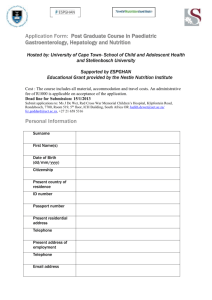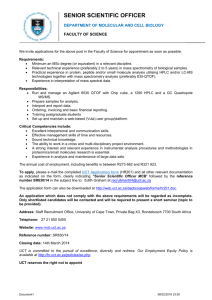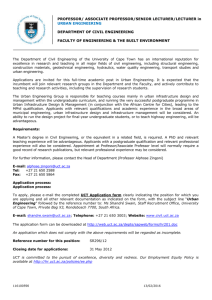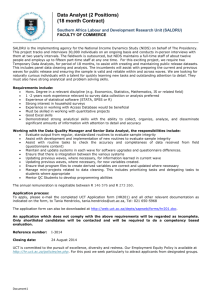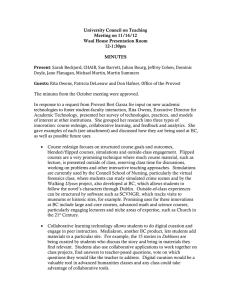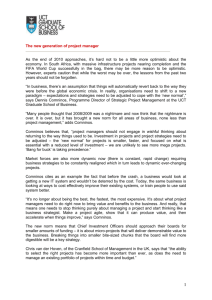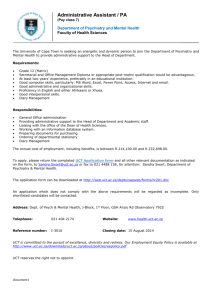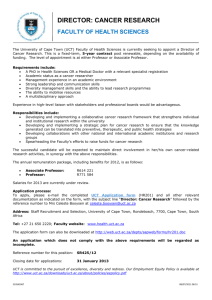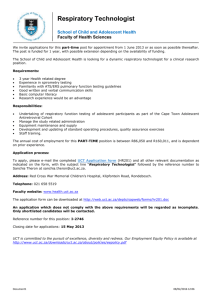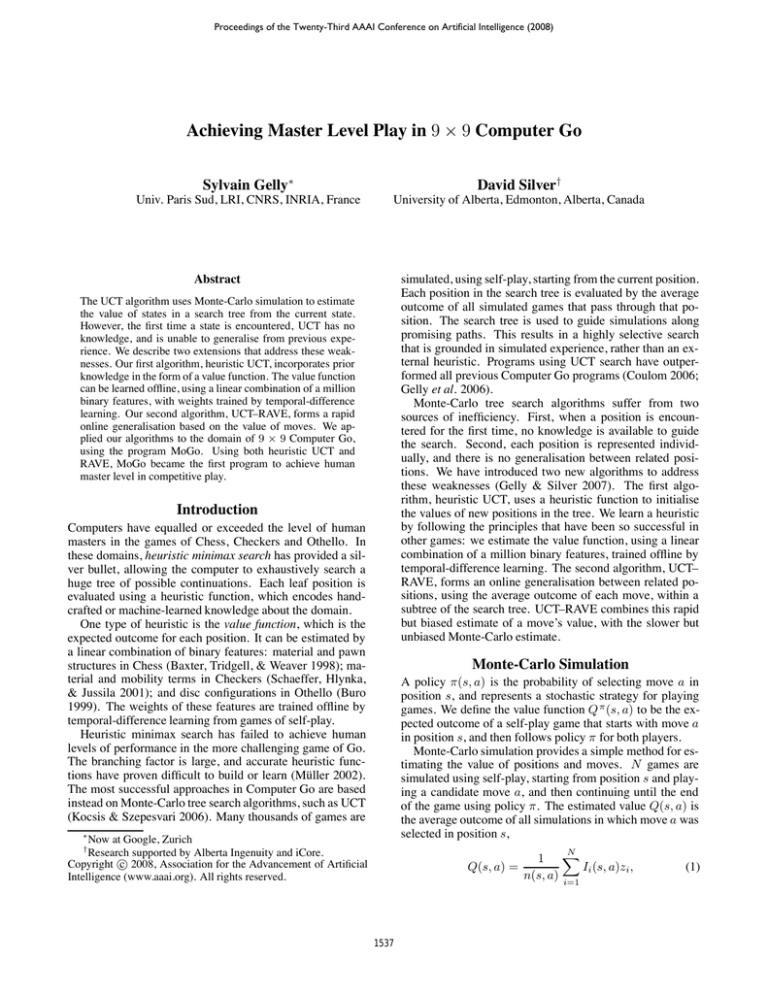
Proceedings of the Twenty-Third AAAI Conference on Artificial Intelligence (2008)
Achieving Master Level Play in 9 × 9 Computer Go
Sylvain Gelly∗
David Silver†
Univ. Paris Sud, LRI, CNRS, INRIA, France
University of Alberta, Edmonton, Alberta, Canada
simulated, using self-play, starting from the current position.
Each position in the search tree is evaluated by the average
outcome of all simulated games that pass through that position. The search tree is used to guide simulations along
promising paths. This results in a highly selective search
that is grounded in simulated experience, rather than an external heuristic. Programs using UCT search have outperformed all previous Computer Go programs (Coulom 2006;
Gelly et al. 2006).
Monte-Carlo tree search algorithms suffer from two
sources of inefficiency. First, when a position is encountered for the first time, no knowledge is available to guide
the search. Second, each position is represented individually, and there is no generalisation between related positions. We have introduced two new algorithms to address
these weaknesses (Gelly & Silver 2007). The first algorithm, heuristic UCT, uses a heuristic function to initialise
the values of new positions in the tree. We learn a heuristic
by following the principles that have been so successful in
other games: we estimate the value function, using a linear
combination of a million binary features, trained offline by
temporal-difference learning. The second algorithm, UCT–
RAVE, forms an online generalisation between related positions, using the average outcome of each move, within a
subtree of the search tree. UCT–RAVE combines this rapid
but biased estimate of a move’s value, with the slower but
unbiased Monte-Carlo estimate.
Abstract
The UCT algorithm uses Monte-Carlo simulation to estimate
the value of states in a search tree from the current state.
However, the first time a state is encountered, UCT has no
knowledge, and is unable to generalise from previous experience. We describe two extensions that address these weaknesses. Our first algorithm, heuristic UCT, incorporates prior
knowledge in the form of a value function. The value function
can be learned offline, using a linear combination of a million
binary features, with weights trained by temporal-difference
learning. Our second algorithm, UCT–RAVE, forms a rapid
online generalisation based on the value of moves. We applied our algorithms to the domain of 9 × 9 Computer Go,
using the program MoGo. Using both heuristic UCT and
RAVE, MoGo became the first program to achieve human
master level in competitive play.
Introduction
Computers have equalled or exceeded the level of human
masters in the games of Chess, Checkers and Othello. In
these domains, heuristic minimax search has provided a silver bullet, allowing the computer to exhaustively search a
huge tree of possible continuations. Each leaf position is
evaluated using a heuristic function, which encodes handcrafted or machine-learned knowledge about the domain.
One type of heuristic is the value function, which is the
expected outcome for each position. It can be estimated by
a linear combination of binary features: material and pawn
structures in Chess (Baxter, Tridgell, & Weaver 1998); material and mobility terms in Checkers (Schaeffer, Hlynka,
& Jussila 2001); and disc configurations in Othello (Buro
1999). The weights of these features are trained offline by
temporal-difference learning from games of self-play.
Heuristic minimax search has failed to achieve human
levels of performance in the more challenging game of Go.
The branching factor is large, and accurate heuristic functions have proven difficult to build or learn (Müller 2002).
The most successful approaches in Computer Go are based
instead on Monte-Carlo tree search algorithms, such as UCT
(Kocsis & Szepesvari 2006). Many thousands of games are
Monte-Carlo Simulation
A policy π(s, a) is the probability of selecting move a in
position s, and represents a stochastic strategy for playing
games. We define the value function Q π (s, a) to be the expected outcome of a self-play game that starts with move a
in position s, and then follows policy π for both players.
Monte-Carlo simulation provides a simple method for estimating the value of positions and moves. N games are
simulated using self-play, starting from position s and playing a candidate move a, and then continuing until the end
of the game using policy π. The estimated value Q(s, a) is
the average outcome of all simulations in which move a was
selected in position s,
∗
Now at Google, Zurich
Research supported by Alberta Ingenuity and iCore.
c 2008, Association for the Advancement of Artificial
Copyright "
Intelligence (www.aaai.org). All rights reserved.
†
N
Q(s, a) =
1537
1 !
Ii (s, a)zi ,
n(s, a) i=1
(1)
where zi is the outcome of the ith simulation: z = 1 if
the player wins the game and z = 0 otherwise. I i (s, a)
is an indicator function returning 1 if move a was selected
in position s during the ith simulation, and 0 otherwise.
"N
n(s, a) =
i=1 Ii (s, a) counts the total number of simulations in which move a was selected in position s. For
example, if the move a was played in 10 out of 100 simulations starting from state s, of which 7 were won and 3
were lost, then we would have N = 100, n(s, a) = 10 and
Q(s, a) = 0.7.
This gives a simple search algorithm for identifying the
best move in the current position s t . Each candidate move in
st is evaluated using Monte-Carlo simulation, and the move
with the highest estimated value is played.
Figure 1: (a) An example position from a game of 9 × 9 Go.
(b) Shapes are an important part of Go strategy. The figure
shows (clockwise from top-left) 1 × 1, 2 × 1, 2 × 2 and 3 × 3
local shape features which occur in the example position.
Monte-Carlo Tree Search
UCT requires no prior domain knowledge to evaluate positions or order moves. Furthermore, the UCT search tree is
highly non-uniform and favours the most promising lines.
These properties make UCT ideally suited to the game of
Go, which has a large state space and branching factor, and
for which no strong evaluation functions are known.
Monte-Carlo tree search builds a search tree of positions and
moves that are encountered during simulations from the current position. There is one node in the tree for each position s and move a, containing a count n(s, a), and a value
Q(s, a) that is estimated by Monte-Carlo simulation (equation 1). Each simulation starts from the current position s t ,
and is divided into two stages: a tree policy is used while
all children are contained in the search tree; and a default
policy is used for the remainder of the simulation. The simplest version of Monte-Carlo tree search uses a greedy tree
policy during the first stage, that selects the move with the
highest value among all child nodes; and a uniform random
default policy during the second stage, that rolls out simulations until completion. The tree is grown by one node
per simulation, by adding the first position and move in the
second stage.
Monte-Carlo tree search can be extended by enhancing
the policy used in each stage of the simulation. A domain
specific default policy can significantly boost the performance of Monte-Carlo algorithms (Gelly et al. 2006). The
tree policy can be significantly improved by encouraging exploratory moves. The UCT algorithm treats each individual position as a multi-armed bandit (Kocsis & Szepesvari
2006), and selects the move a in position s with the greatest
upper confidence bound Q ⊕ (s, a) on its value,
#
log n(s)
⊕
.
(2)
Q (s, a) = Q(s, a) + c
n(s, a)
Heuristic UCT
Monte-Carlo tree search evaluates positions and moves by
simulating experience from the current position s t . However, when only a few relevant simulations have been experienced, the value estimates have high variance. Furthermore,
the search tree grows exponentially with depth, and thus the
vast majority of nodes in the tree are experienced rarely.
One way to reduce the uncertainty for rarely encountered positions is to incorporate prior knowledge, by using
a heuristic function Q h (s, a). When a node is first added
to the search tree, it is initialised according to the heuristic
function, Q(s, a) = Q h (s, a) and n(s, a) = nh (s, a). The
quantity nh indicates our confidence in the heuristic in terms
of equivalent experience. This corresponds to the number of
simulations that UCT would require to achieve a value of
similar accuracy1. After initialisation, the value and count
are updated using standard Monte-Carlo simulation.
Learning a Heuristic for Computer Go
We learn a value function as a heuristic, that estimates the
expected outcome of the game. The value function is approximated by a linear combination of binary features φ with
weights θ,
$
%
Qh (s, a) = σ φ(s, a)T θ
(3)
where n(s) counts the total number of visits to position s,
and c is a constant determining the level of exploration. Similarly, opponent moves are selected by minimising a lower
confidence bound on the value.
Typically, many thousands of games are simulated per
move, building an extensive search tree from the current
position st . There is a cycle of policy improvement and
evaluation: as the tree grows, the tree policy becomes more
informed; and as the tree policy improves, the values in
the tree become more accurate. Under certain assumptions about non-stationarity, UCT converges on the minimax value (Kocsis & Szepesvari 2006). However, unlike
other minimax search algorithms such as alpha-beta search,
where σ is the logistic function σ(x) = 1+e1− x , which
squashes the linear combination into the range [0, 1]. We
use temporal difference learning (Sutton 1988) to update the
weights, trained offline from games of self-play,
δ
∆θi
= Qh (st+1 , at+1 ) − Qh (st , at )
= αδφi (st , at )
where δ is the TD-error and α is a step-size parameter.
1
1538
This is equivalent to a beta prior if binary outcomes are used.
0.7
UCT
UCT–RAVE
0.75
Local shape features
Handcrafted heuristic
Grandfather heuristic
Even game heuristic
UCT–RAVE
0.65
0.7
Winning rate against GnuGo 3.7.10 default level
Winning rate against GnuGo 3.7.10
0.6
0.55
0.5
0.45
0.4
0.35
0.3
0.25
0.2
0.65
0.6
0.55
0.5
0.45
1
10
100
1000
10000
k
0.4
0
Figure 2: Winning rate of UCT–RAVE with 3000 simulations per move against GnuGo 3.7.10 (level 10), for different
settings of the equivalence parameter k. The bars indicate
the standard error. Each point of the plot is an average over
2300 complete games.
150
200
Figure 3: Winning rate of heuristic UCT–RAVE with 3000
simulations per move against GnuGo 3.7.10 (level 10), using
different heuristics, and using a constant level of equivalent
experience n̂ h . The bars indicate the standard error. Each
point of the plot is an average over 2300 complete games.
Consider a maze in which the agent starts on the left
and searches for an exit on the right. The search quickly
branches into two regions: in the top of the maze, moving
right and down typically leads to success; in the bottom of
the maze, moving right and up are usually most successful.
The RAVE algorithm enables the agent to generalise from
these observations. When the agent encounters an unseen
state, it knows to try the actions that were previously successful in this region of the search tree.
Rapid Action Value Estimation (RAVE)
UCT learns a unique value for each node in the search tree,
estimated online from experience simulated from the current
position. However, it cannot generalise between related positions. The RAVE algorithm provides a simple way to share
experience between classes of related positions, resulting in
a rapid, but biased value estimate.
The RAVE value Q̂(s, a) is the average outcome of all
simulations in which move a is selected in position s, or in
any subsequent position,
Combining UCT and RAVE
The Monte-Carlo value Q(s, a) is unbiased, but may be high
variance if insufficient experience is available. The RAVE
value Q̂(s, a) is biased, but lower variance; it is based on
more experience, but this generalisation may not always be
appropriate. Hence we rely predominantly on the RAVE
value initially, but gradually shift to the Monte-Carlo value,
by using a linear combination of these values with a decaying weight . An equivalence parameter k controls the
number of simulations when both estimates are given equal
weight (Gelly & Silver 2007).
The results of UCT–RAVE are shown in Figure 2. The
winning rate against GnuGo (level 10) reaches 60%, compared to 24% without RAVE. Maximum performance is
achieved with an equivalence parameter of 1000 or more.
This indicates that each RAVE value is worth several thousand Monte-Carlo simulations.
N
1 !ˆ
Ii (s, a)zi ,
n̂(s, a) i=1
100
n̂h
In the game of Go, the notion of shape has strategic importance. For this reason we use binary features φ(s, a) that
recognise local patterns of stones (Silver, Sutton, & Müller
2007). Each local shape feature matches a specific configuration of stones and empty intersections within a particular
square on the board (Figure 1). Local shape features are created for all configurations, at all positions on the board, from
size 1 × 1 up to 3 × 3. Rotational, reflectional and translational symmetries are exploited by sharing weights between
equivalent features.
Q̂(s, a) =
50
(4)
where Iˆi (s, a) is an indicator function returning 1 if position
s was encountered at any step k of the ith simulation, and
move a was selected at any step t >= k, or 0 otherwise.
"N
n̂(s, a) = i=1 Iˆi (s, a) counts the total number of simulations used to estimate the RAVE value.
The RAVE value Q̂(s, a) generalises the value of move a
across all positions in the subtree below s, and subsequent
positions encountered during the default policy. It is closely
related to the history heuristic in alpha-beta search (Schaeffer 1989), and the all moves as first heuristic in Computer
Go (Bruegmann 1993).
Heuristic UCT–RAVE
The heuristic UCT and UCT–RAVE algorithms can be combined by initialising the RAVE values to the heuristic function, Q̂(s, a) = Qh (s, a) and n̂(s, a) = n̂h (s, a). The quantity n̂h indicates our confidence in the heuristic in terms of
1539
Algorithm
UCT
UCT
UCT–RAVE
Heuristic UCT–RAVE
equivalent experience for the RAVE value.
We compared the performance of four different heuristic
functions: 1. A learned value function using local shape
features. 2. A handcrafted heuristic based on MoGo’s
domain specific knowledge. This heuristic was designed
such that greedy move selection would produce the best
known default policy for MoGo, as described by Gelly et
al. (2006). 3. A grandfather heuristic that assumes that the
current value is similar to the overall value (after all simulations were completed) last time the agent was to play,
Qh (st , at ) = Q(st−2 , at ). 4. An even-game heuristic,
Qh (s, a) = 0.5, that assumes even positions are more likely
than clearly won or lost positions. Figure 3 shows the performance of MoGo against GnuGo 3.7.10, using heuristic
UCT–RAVE for constant values of n̂ h , for all four heuristic
functions.
Heuristic UCT–RAVE with a good heuristic significantly
outperformed the basic UCT–RAVE algorithm. Local shape
features provided the best performance across a wide range
of equivalent experience, and appear to be worth around 50
simulations of experience 2. However, a poor heuristic can
hurt performance, particularly when it is trusted too heavily
- as demonstrated by the misleading grandfather heuristic.
Default Policy
Uniform random
MoGo
MoGo
MoGo
Wins .v. GnuGo
1.84 ± 0.22 %
23.88 ±0.85%
60.47 ± 0.79 %
69 ± 0.91 %
Table 1: Winning rate of the different UCT algorithms
against GnuGo 3.7.10 (level 10), given 3000 simulations per
move. The numbers after the ± correspond to the standard
error from several thousand complete games.
Simulations
3000
10000
70000
Wins .v. GnuGo
69%
82%
92%
CGOS rating
1960
2110
2320
Table 2: Winning rate of heuristic UCT–RAVE against
GnuGo 3.7.10 (level 10) for increasing number of simulations, and MoGo’s rating on the Computer Go Online Server.
Buro, M. 1999. From simple features to sophisticated
evaluation functions. In First International Conference on
Computers and Games, 126–145.
Coulom, R. 2006. Efficient selectivity and backup operators in Monte-Carlo tree search. In 5th International
Conference on Computer and Games, 2006-05-29, 72–83.
Gelly, S., and Silver, D. 2007. Combining online and offline learning in UCT. In 17th International Conference on
Machine Learning, 273–280.
Gelly, S.; Wang, Y.; Munos, R.; and Teytaud, O. 2006.
Modification of UCT with patterns in Monte-Carlo Go.
Technical Report 6062, INRIA.
Kocsis, L., and Szepesvari, C. 2006. Bandit based MonteCarlo planning. In 15th European Conference on Machine
Learning, 282–293.
Müller, M. 2002. Computer Go. Artificial Intelligence
134:145–179.
Schaeffer, J.; Hlynka, M.; and Jussila, V. 2001. Temporal
difference learning applied to a high-performance gameplaying program. In Proceedings of the Seventeenth International Joint Conference on Artificial Intelligence, 529–
534.
Schaeffer, J. 1989. The history heuristic and alphabeta search enhancements in practice. IEEE Transactions on Pattern Analysis and Machine Intelligence PAMI11(11):1203–1212.
Silver, D.; Sutton, R.; and Müller, M. 2007. Reinforcement
learning of local shape in the game of Go. In 20th International Joint Conference on Artificial Intelligence, 1053–
1058.
Sutton, R. 1988. Learning to predict by the method of
temporal differences. Machine Learning 3(9):9–44.
Conclusion
Monte-Carlo tree search algorithms such as UCT provide
a new framework for search. Instead of requiring human
knowledge to evaluate leaf positions, evaluation is grounded
in the outcomes of simulations. Instead of considering all
possible continuations, simulations are sampled selectively.
Instead of explicitly computing the minimax solution, it
emerges from an incremental process of policy improvement
and evaluation within the search tree. In large, challenging
domains such as Computer Go, these differences appear to
be critical to success.
The UCT algorithm can be signficantly improved by using a heuristic to provide prior knowledge within the search
tree, and by using a simple generalisation to accelerate online learning. Each improvement is cumulative (see Table
1), and scalable (see Table 2).
Using a combination of heuristic UCT and UCT–RAVE,
the program MoGo achieved a rating of 3–dan (strong master level) in 9 × 9 Go games against human players on the
Kiseido Go Server; became the highest rated program on
both 9 × 9 and 19 × 19 Computer Go servers; won the gold
medal at the 2007 Computer Go Olympiad; and became the
first program to beat a human professional player at 9 × 9
Go.
References
Baxter, J.; Tridgell, A.; and Weaver, L. 1998. Experiments
in parameter learning using temporal differences. International Computer Chess Association Journal 21(2):84–99.
Bruegmann, B.
1993.
Monte-Carlo Go.
http://www.cgl.ucsf.edu/go/Programs/Gobble.html.
2
Subsequent versions of the handcrafted heuristic outperform
the learned heuristic, and are used in the competitive MoGo.
1540

